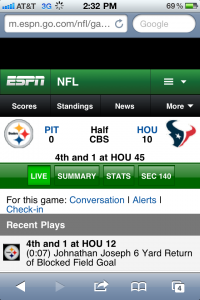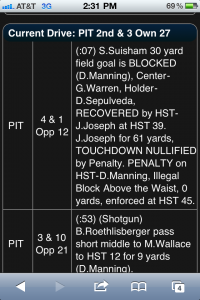I love football, and I love all the ways that technology lets me keep up with my favorite team. When I can't get to a TV, I rely on play-by-play services on sites like
ESPN and
CBS Sports to track the action on the field.
From a user experience perspective, it might seem like these sorts of services would be pretty straightforward: Something happens, and you tell people about it. But it turns out to be a tougher problem. In a live event, things are always changing: penalties happen, rulings get overturned, and instant replay can take points off the board. How do on-the-go fans expect to learn about what's happening?
Recently, I tried out two different sites that took two very different approaches to that problem. I was en route home to San Francisco, following along with my beloved Pittsburgh Steelers using ESPN's website on my mobile phone. My team had been shut out, but just before halftime, they were setting up to kick an easy field goal. Hooray! But when I refreshed the play-by-play to see the score, the update held terrible news: Players from the other team had blocked the kick and returned it for a touchdown.
Or had they?
The play-by-play stream started popping up a stream of ever-more-baffling updates. The points were taken away, but the report of the most recent play still read TOUCHDOWN. The game clock stalled. Was it halftime? Or was the game still going? Was there a penalty? Was the score still 10-0, or was it 17-0?
Here's how my screen looked about five minutes after the kick:

Feeling confused — and unsure just how badly my team was losing — I clicked over to the similar play-by-play site on CBS Sports. Here's how that site explained what had happened:

Ah. NOW I get it.
The ESPN site prioritized giving me the most recent information available — but without showing the full sequence of events or any context that would help me make sense of what I was seeing. The CBS site, on the other hand, listed out every single part of the play. It verged on
too much information, but it let me follow along with the steps that had led to the ultimate outcome. That approach was closer to what I would have seen if I had actually been watching the game.
Ultimately, the CBS site better fit my mental model of how football unfolds and how I would expect to learn about changes in plays. It anticipated what I would need as a fan and what questions I would want to have answered — and that made it the better experience overall.